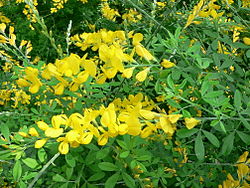| Genista stenopetala | |
|---|---|
 | |
| Scientific classification | |
| Kingdom: | Plantae |
| Clade: | Tracheophytes |
| Clade: | Angiosperms |
| Clade: | Eudicots |
| Clade: | Rosids |
| Order: | Fabales |
| Family: | Fabaceae |
| Subfamily: | Faboideae |
| Genus: | Genista |
| Species: | G. stenopetala |
| Binomial name | |
| Genista stenopetala | |
| Synonyms [1] | |
| |
Genista stenopetala, the sweet broom, Easter broom or leafy broom (syn. Genista spachiana, Cytisus spachianus), is a species of flowering plant in the legume family Fabaceae, native to the Canary Islands, on La Palma and Tenerife.